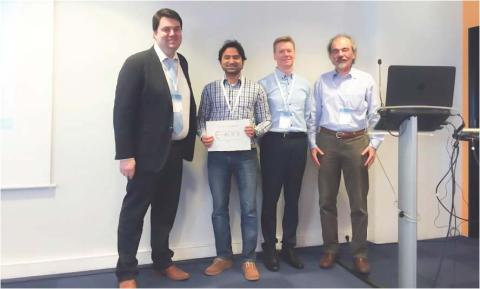ECE Ph.D. student Saiful Alam won the Best Poster Award at the 2016 European Materials Research Society Spring Meeting, held May 2-6 in Lille, France.
Saiful Alam won the Best Poster Award at the 2016 European Materials Research Society Spring Meeting, held May 2-6 in Lille, France. Alam is a Ph.D. student in the School of Electrical and Computer Engineering (ECE) and is based at Georgia Tech-Lorraine (GTL). He is advised by ECE Professor and GTL Director Abdallah Ougazzaden.
Alam received the award for his poster entitled “Investigation of p-contact performance for InGaN/InGaN Multi Quantum Well (MQW) light emitting diodes emitting in blue to green region.” His coauthors on the paper are Ougazzaden, Suresh Sundaram (GTL-CNRS), Xin Li (ECE, Atlanta campus), Youssef El Gmili (CNRS), Helge Haas (CEA-LETI Minatec Campus), Miryam Elouneg-Jamroz (CEA-LETI Minatec Campus), Ivan Christophe Robin (CEA-LETI Minatec Campus), Paul Voss (ECE, GTL campus), and Jean-Paul Salvestrini (University of Lorraine).
Solid state lighting has received much attention for its potential to reduce energy consumption up to 85 percent, compared to conventional lighting. GaN-based light emitting diodes (LEDs) have applications for solid state lighting because the tunable bandgap of InGaN/GaN-based Multi Quantum Well (MQW) LEDs makes it possible to produce light across the entire visible spectral range.
To realize good quality white light with high Color Rendering Index (CRI), monolithic integration of Red-Green-Blue (RGB) is important. Though blue LED has fairly good performance and has been commercially successful, Green LED efficacy is less than 50 percent and still needs to improve to get high CRI white light by RGB combination for solid state lighting. Therefore, for structures with higher Indium (In) content in InGaN alloys like green LEDs, improvement from InGaN architecture to p-contact performance is still necessary, and to compete with conventional lighting, the extraction efficiency is yet to be improved, particularly in the “green-gap” regime.
Epitaxial growth of p-GaN for green LEDs must be done at a lower temperature than conventional GaN growth temperature to avoid phase segregation of In due to thermal load on MQW from temperature during p-GaN growth. Hence, the study of p-GaN growth temperature and contact performance for these devices is important for the success of solid state lighting.
Photo caption: Pictured with Saiful Alam (2nd from left) are Daniel Alquier, professor and deputy director of GREMAN project at the University of Tours; Yvon Cordier, CNRS research director, head of CRHEA-CNRS, and Konstantinos Zekentes, principal researcher at the Institute of Electronic Structure and Laser of the Foundation for Research and Technology-Hellas.
